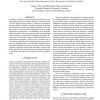Free Online Productivity Tools
i2Speak
i2Symbol
i2OCR
iTex2Img
iWeb2Print
iWeb2Shot
i2Type
iPdf2Split
iPdf2Merge
i2Bopomofo
i2Arabic
i2Style
i2Image
i2PDF
iLatex2Rtf
Sci2ools
127
Voted
WIAMIS
2009
IEEE
2009
IEEE
Adaptive gesture recognition in Human Computer Interaction
An adaptive, invariant to user performance fluctuation or noisy input signal, gesture recognition scheme is presented based on Self Organizing Maps, Markov Models and Levenshtein sequence distance. Multiple modalities, all based on the hand position during gesturing, train different classifiers which are then fused in a weak classifier boosting-like setup by weight assignment to each stream. The adaptability of the proposed approach consists of the incorporation of Self Organizing Maps during training, the exploitation of neighboring relations between states of the Markov models and the modified Levenshtein distance algorithm. The main focus of current work is to tackle intra and inter user variability during gesture performance by adding flexibility to the decoding procedure and allowing the algorithm to perform an optimal trajectory search while the processing speed of both the feature extraction and the recognition process indicate that the proposed architecture is appropriate...
Image Analysis | Levenshtein Sequence Distance | Markov Models | Self Organizing Maps | WIAMIS 2009 |
Related Content
| Added | 21 May 2010 |
| Updated | 21 May 2010 |
| Type | Conference |
| Year | 2009 |
| Where | WIAMIS |
| Authors | George Caridakis, Kostas Karpouzis, Athanasios I. Drosopoulos, Stefanos D. Kollias |
Comments (0)

